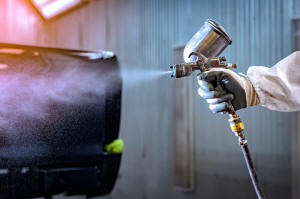Permits
State and federal law requires that districts use a
permit process to ensure that equipment and processes
are operated in compliance with all air pollution
regulations. This is one way that the district and
businesses work together to clean the air and protect
public health in Ventura County.
Which businesses need permits?
Facilities of any size with equipment that could emit
air pollutants need permits. Some of the affected
businesses include:
-
 Dry cleaners
Dry cleaners
- Gas stations
- Facilities that use solvents or paints
- Facilities that use gas- or oil-fired equipment with a
capacity of 1 million Btu/hour or higher or internal
combustion engines of 50 horsepower or higher
- Bulk petroleum operations
- Oil production facilities
- Power plants
- Sand, gravel and cement operations
For more detailed information, review the
list of common
equipment and processes that require permits and
Rule 23
— Exemptions From Permit. Portable engines enrolled in
the
California Air Resources Board Portable Equipment
Registration Program do not require district permits.
When are permits required?
- Before installing new equipment
- Before implementing new processes
- Before modifying existing equipment
- When ownership of a facility changes
- When equipment is moved to a new address
- When an operation method is changed
- When a facility operator wants to modify permit
conditions, including limits on fuel or material use
How do I obtain verification that a permit is not
needed?
Download an
Occupancy Permit Review Questionnaire
(AB3205 form), complete it and email it to
notifications@vcapcd.org. An AB3205 form signed by a
district staff member may be required to obtain city or
county building permits or comply with asbestos
regulations for renovation or demolition operations.
What are the types of permits?
• Authority to Construct
- It must be issued before construction, installation or
modification begins to allow for district review of
applicable rules before an emissions unit is installed.
- It requires that a district engineer evaluate
information in the application for compliance with
local, state and federal rules.
• This evaluation includes the district’s New Source
Review requirements for Best Available Control
Technology (BACT) and offsets, which are detailed in
Rule 26.2. BACT is required for any emission increase of
reactive organic compounds (ROC), nitrogen oxides (NOx),
course particulate matter (PM10) or sulfur oxides (SOx).
If offset thresholds are exceeded, emission increases
must be offset with Emission Reduction Credits.
- It is not required for small sources as defined in
Rule 11.
• Permit to Operate
-
 Medium and large sources apply for this permit after
construction authorized by an Authority to Construct is
complete but before operation begins. Small sources
apply directly for a Permit to Operate.
Medium and large sources apply for this permit after
construction authorized by an Authority to Construct is
complete but before operation begins. Small sources
apply directly for a Permit to Operate.
- It requires that district personnel inspect the
facility to verify that the equipment performs as
designed in compliance with district rules and
regulations. The district may issue a temporary Permit
to Operate to allow for emission testing or inspection
while the facility is operating.
- Stack testing by an independent contractor employed by
the applicant may be required to demonstrate compliance.
The California Air Resources Board maintains a
list of
approved contractors.
- It lists all emitting units at the facility.
- It specifies allowed, or permitted, emissions
- It details specific operating conditions to comply
with district, state and federal rules.
- It includes annual limits on fuel and material use
depending on the type of emissions unit.
How is the size of a source determined?
Classification is based on the type and location of
equipment, amount of pollutants emitted and special
requirements, such as air toxics reviews.
How do I apply?
- Call (805) 303-3688 to discuss the project if you have
questions about requirements or the permit application
process.
- Download the appropriate forms.
- Submit the following to the district by email at
engineering@vcapcd.org or in person at or by mail to
Ventura County Air Pollution Control District, 4567
Telephone Road Second Floor, Ventura, CA 93003:
o Cover letter containing a business description and
details on the proposed equipment and processes
o Completed and signed application form
o Supplementary forms for specific equipment or
processes, as needed
o Equipment specification sheets and block flow diagrams
of the processes
o Street map showing the facility location
o Sketch or map showing land uses adjacent to the
facility
o Sketches of the facility layout and floor plan showing
the location of the equipment and processes
o $450 application filing fee paid by check or online
with receipt sent to
engineering@vcapcd.org
How long does the process take?
Processing time ranges from 30 to 180 days depending on
the complexity of the application. Within 30 days of
submission, you will be notified that the application is
complete or additional information is needed.
What fees are there?
- Application filing fee for each Authority to Construct
and Permit to Operate
- Application processing fee based on the amount of time
required to process each Authority to Construct and
Permit to Operate Without Authority to Construct
- Permit to Operate fee charged upon approval to cover
first-year annual operating fees and, if required, the
cost of witnessing or approving a source test
- Annual renewal fee billed for each subsequent year
based on the permitted emissions
o If the invoice is not paid within 60 days of being
sent, the permit will be voided. A permit is reinstated
upon payment of renewal fee and incremental late fees.
For fee amounts, see
Rule 42 and the
Permit Fee
Schedule.
What is the renewal process for a Permit to Operate?
Pursuant to Rule 42.H, all permits must be renewed
annually. A permit is valid until the expiration date on
it or 60 days after the renewal fee notice is mailed,
whichever is later. Each year, district staff review
emission data and modify permit conditions as needed.
Equipment that has been permanently removed is removed
from the permit. If changes to permitted equipment or
emissions are made, a draft permit is sent to the holder
for review along with the renewal fee invoice. Renewal
requires fee payment.
Facilities with federal Title V Operating Permits are
subject to a five-year permit period and a Reissuance
application requirement but still must pay annual
renewal fees to the district.
What happens if a facility is operated without a permit?
It is subject to legal action and penalties of up to
$100,000 or more per day and/or one year in jail.
More information:
For additional details on the district’s permit rules,
review
Regulation II. If you have questions, contact the
Engineering Division at (805) 303-3688 or
engineering@vcapcd.org.


 Dry cleaners
Dry cleaners  Medium and large sources apply for this permit after
construction authorized by an Authority to Construct is
complete but before operation begins. Small sources
apply directly for a Permit to Operate.
Medium and large sources apply for this permit after
construction authorized by an Authority to Construct is
complete but before operation begins. Small sources
apply directly for a Permit to Operate.